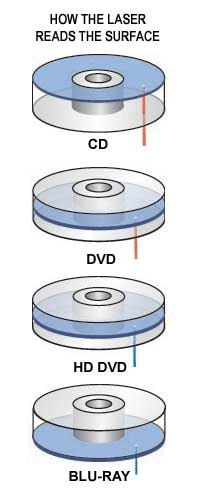Inside Blu-ray & HD DVD Page 3
Two more audio formats we'll be hearing on both HD DVD and Blu-ray are Dolby True HD and DTS HD Master Audio. While both can provide up to eight discrete channels, like DD Plus, they use 24-bit encoding and a 192-kHz sampling rate to allow wider dynamic range and frequency response. And both use lossless digital coding that enables bit-for-bit reconstruction of the original audio signal. These new high-resolution lossless formats require much higher data rates, however - up to 18 Mbps for Dolby True HD and 24 Mbps for DTS HD Master Audio.
 There is a downside, though. While the new discs will remain compatible with current gear by defaulting to standard DD and DTS bitstreams through the regular digital audio output on your player, you'll need to upgrade your digital surround receiver to one with an HDMI connection and enhanced decoding to experience the new audio formats in their full 7.1-channel, high-rez glory.
There is a downside, though. While the new discs will remain compatible with current gear by defaulting to standard DD and DTS bitstreams through the regular digital audio output on your player, you'll need to upgrade your digital surround receiver to one with an HDMI connection and enhanced decoding to experience the new audio formats in their full 7.1-channel, high-rez glory.
Interactive Extras Everybody seems to like DVD extras, whether they're behind-the-scenes features on special effects or Easter eggs unlocking previously unknown treasures. (Although some of these "treasures" might even be unwanted, like the deleted scene on the Boogie Nights Special Edition disc revealing actor John C. Reilly's butt.) Happily, both HD DVD and Blu-ray are poised to take extras to interesting new heights. One reason is the sheer storage capacity of both formats. Along with a high-def movie, a single-layer Blu-ray or HD DVD can hold many hours of standard-def video features. But a bigger reason is the new interactive systems designed to exploit the players' data connections.
Most people won't care what flavor of interactivity a player uses because they'll get to experience the same cool stuff regardless. For instance, multiple video and audio streams will let you watch the director commentary via an onscreen overlay while the movie runs in the background. You'll also be able to navigate onscreen menus and perform chapter searches without stopping the movie. And if your player is hooked up to a home network, you'll have access to related Web links, games, and online shopping features.
HD DVD's interactivity specification is called iHD, while Blu-ray uses Blu-ray Disc Java, or BD-J. The main difference is that iHD, which was developed by Microsoft and Disney, is based on XML (Extensible Markup Language), a text-based format that allows a wide range of data to be easily exchanged over the Web. BD-J, meanwhile, is based on Sun Microsystems' Java, an environment that, interestingly, was originally created for use in home-entertainment devices.
Microsoft - an exclusive backer of HD DVD - holds a secret weapon in the format war, since it plans to make its forthcoming Windows Vista operating system iHD-compatible. This no doubt sweetens the deal for computer companies, who will have to pay royalties to incorporate third-party software support for Blu-ray disc drives. (Not surprisingly, computer maker HP, which had previously thrown its weight behind Blu-ray, recently decided to support both formats.) Toshiba has announced that its first two HD DVD players -the HD-AX1 and HD-A1 - won't handle the full suite of iHD interactivity when they go on sale. But the company has said it will eventually make a firmware upgrade available so first-gen players can take advantage of all the interactive features on HD DVD releases.
- Log in or register to post comments

























































